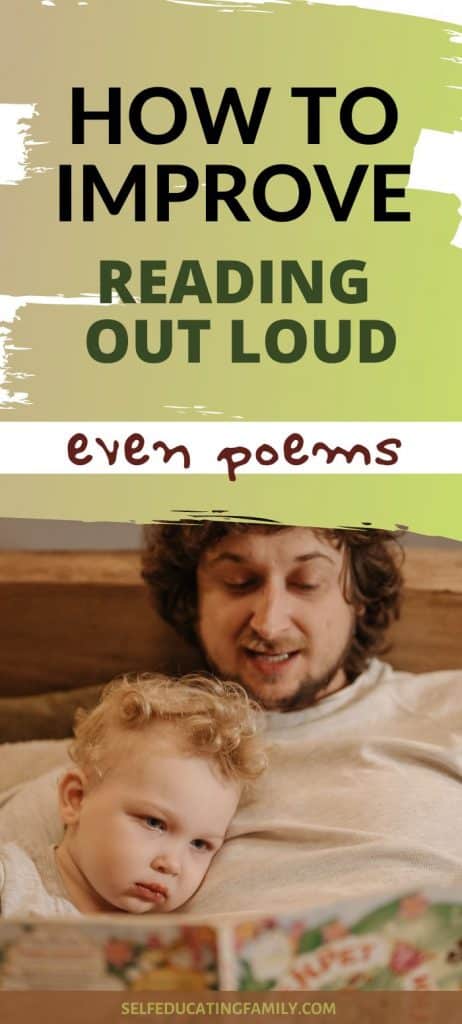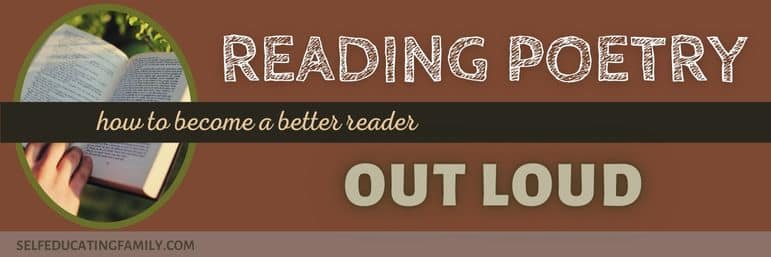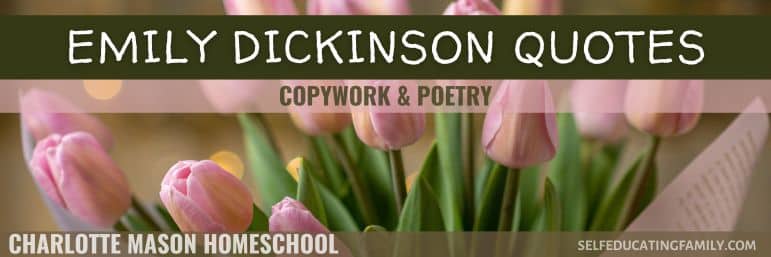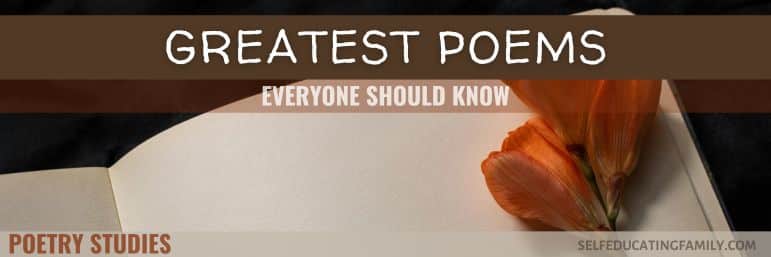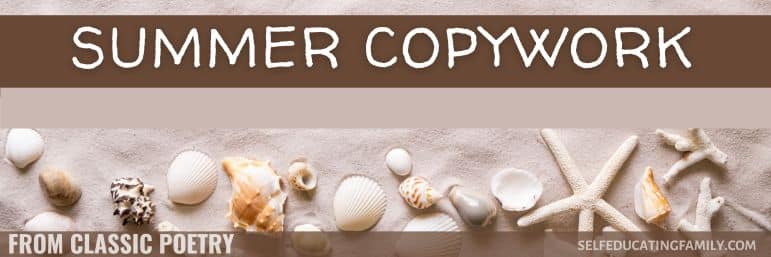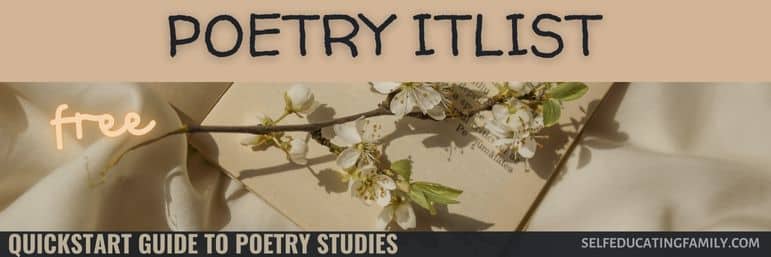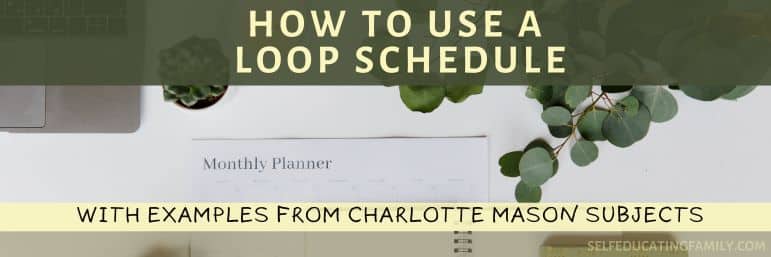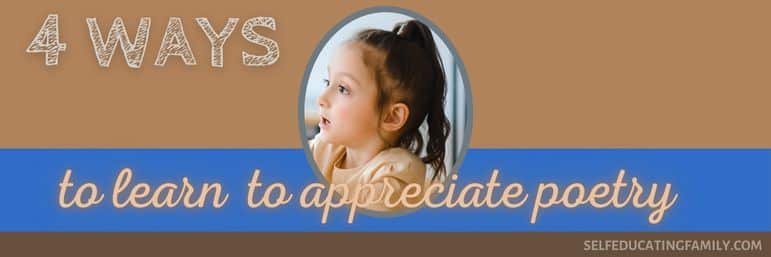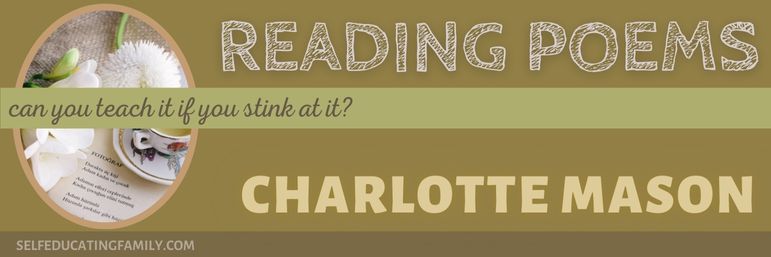Poems need to be read out loud
In order to actually begin to appreciate poetry, you have to start reading poems out loud.
For a rounded education, even for kids that are math & science-oriented, I have finally come around to the idea that kids need to hear poetry read out loud.
Two Biggest Problems
The biggest problem is that most people (not to mention most kids) are NOT GOOD at reading poetry aloud.
The second biggest problem is that some people cannot hear the content when someone else reads aloud.
- This was another of my problems growing up and why I disliked poetry as it was taught in schools. I am not an auditory learner. In fact, I can’t stand listening to someone reading something, usually. I want to just read it myself.
- This post will NOT deal with non-auditory learners – they will just have to learn to read poetry themselves so they don’t have to listen to someone else reading it.
So, back to the BIGGEST problem, that most people are NOT GOOD at reading out loud.
But with a little effort, you can be.
Two Solutions to not being able to read aloud well
- Find someone who is good at reading out loud.
- Librivox might be a good option, but sometimes the readers there are not as good as one hopes.
- Books on tape might be a good resource.
- Alternatively, just learn to read aloud well yourself.
Why you might want to be good at reading aloud
If you can read out loud well, it can serve you throughout life. Applications include:
- Speechcraft
- Reading to your kids
- Telling stories
- Reading poems
- Running meetings, even via Zoom
- Acting in plays
- Learning the language that you are reading
- More appreciation of the poems you read
- Recitation
- and many more…
Note on Recitation
Charlotte Mason homeschooling uses recitation in its educational methods. Poetry is extremely well suited to recitation once you learn how to read poems out loud well.
Learn to read out loud
Elements of a good reader include the following:
- Vocal variety: This means not being monotone. Control of the variety in your voice breathes life into your words.
- Rhythm, pace, and timing: Good pacing of what you are reading can build emotional interest in the story and help to captivate your audience. Proper pauses are especially beneficial to allowing the audience to catch up to what you are saying.
- Tone, volume, and energy: Consider the text you are reading to deliver how you read it. Barbara Braxton, a Teacher Librarian at The Bottom Shelf thinks, “Using your voice to complement the text and illustrations is the magic of reading aloud.”
Practice
Finally, the only way to actually improve how you read aloud is to practice.
Practice, practice, practice.
How do you get to the Met?
-Famous old joke
PRACTICE!
Specifics for reading poetry out loud
Start with easy children’s poems and work up from there.
For poetry, there are 3 main things to figure out with a poem when you read it out loud. Pre-read the poem to see if you can find these three things.
Pre-reading a poem is reading ahead of speaking it out loud so you can hear your voice in your own head as you read it.
Find these 3:
- Find the meter or rhythm. Poets often use this to build the poem. Don’t fight it, but also don’t get into a sing-song boring-ness. If the meter is strong, work with it, but if you sound bored or sing-songy, your listener will think it’s boring.
- Example: nursery rhymes. If you read Humpty Dumpty right after Jack & Jill you might sound repetitive in a way that lulls your audience to sleep. But if you vary the pacing or dynamics, you can keep them interested even though they are so similar in rhythm. Of course, if you are trying to lull a child to sleep with a bedtime story, then go for quiet and boring.
- Find the punctuation and ignore the line breaks. Poems often (generally) are written with line breaks all over the place. That’s part of what makes it verse. But sometimes, to get the meter or emphasis right, the poet will break the line in the middle of a phrase. Look for the commas – a comma is a PAUSE. Pause at the commas or other punctuation that tells you to stop.
- Pausing at COMMAS is critical to reading poems.
- Poets choose words carefully so how the words sound is very important. Look for assonance, alliteration, or onomatopoeia to guide how you sound.
- Assonance (same vowel sounds) example from Wordsworth’s Daffodils: “A host, of golden daffodils; Beside the lake, beneath the trees, Fluttering and dancing in the breeze…”
- Alliteration (same starting sounds) example from Shakespeare’s Romeo & Juliet: “From forth the fatal loins of these two foes; A pair of star-crossed lovers takes their life.”
- Onomatopoeia (words that sound the same as they are) example from “Old MacDonald Had a Farm”: “Quack, quack here, quack, quack there. Oink, Oink here, Oink, oink there…”
To read poetry, find the commas and ignore the line breaks.
Final tip
When you actually read the poem aloud after you have pre-read it and you are ready to read it out loud, go slower than you think. Racing through it can make you trip.
FAQ
- What is reading poetry called?
- Reading poetry aloud is called recitation, poetry reading, slam poetry, or poetry performance.
- What are tips for reading poetry?
- Work with the poem:
- Find the meter or rhyme scheme.
- Pause at the commas, not the line breaks.
- Find the special-sounding words.
- Work with the poem:
- What are the benefits of reading poetry?
- Reading poetry is good for your brain and can bring beauty and truth for your brain to chew on.
Keep Learning
Get my Free Curated Poetry QuickStart Guide
Click below to go to my ItList “Add Poetry to Your Day: Quick Start Guide”. It’s free and it will help you get started with Poetry Studies.
Related articles:
More:
- How to Read Poetry
- Importance of Vocal variety from Toastmasters
- 5 ways to improve reading aloud
- The art of reading aloud
